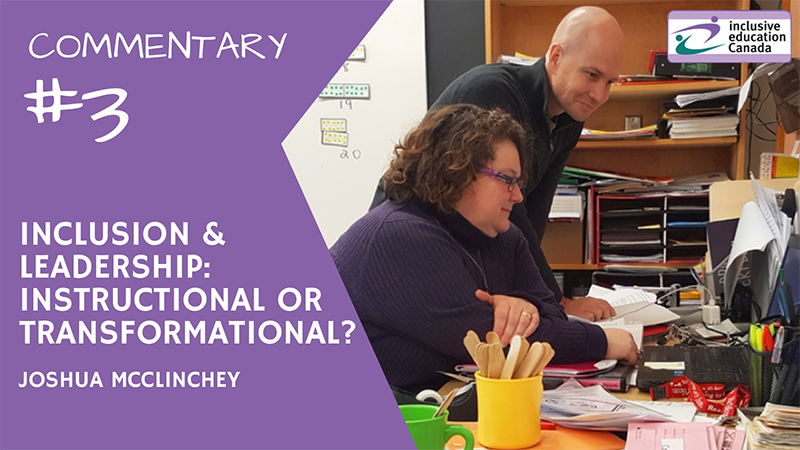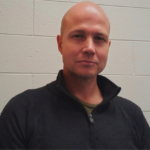 National Inclusive Education Month Commentary #3
National Inclusive Education Month Commentary #3
By Joshua McClinchey, Learning for All Coach, Avon Maitland District School Board, Ontario
In 2007 (and again in 2015), Vivian Robinson investigated the effectiveness of instructional leadership when compared to transformational leadership. When I read School Leadership and Student Outcomes: Identifying What Works and Why, Dr. Robinson’s words struck a chord with me. I have to admit that I had hoped transformational leadership would affect student outcomes in a greater way. These articles caused me to reflect on my own practice and reevaluate what I am doing to better the educational experience of the students I work with.
My role is that of a ‘Learning for All Coach’. After 12 years in the classroom, I now partner with teachers to build specialized lessons and supports for students with complex learning needs. I use the word specialized because I believe that as self-contained classrooms are phased out, special education is replaced by specialized educators. I consider coaching to be a leadership role, but reading these articles had me rethinking which side of the pendulum my responsibilities lie. In a way, because I build and support inclusion in classrooms, my role is transformational. The Business Dictionary defined transformational leadership as a style where the leader “…identifies the needed change, creates a vision to guide the change through inspiration, and executes the change with the commitment of the members of the group” (www.businessdictionary.com). However, because I partner with teachers, identify very specific instructional needs, and focus almost all of my efforts in improving practice by suggesting and implementing inquiry-based strategies, my role involves a great deal of instructional leadership. The mandate of my role is to increase the quality of the educational experience for students with a variety of needs.
With this in mind, I find myself floating somewhere in the middle of instructional and transformational leadership. With the irrefutable evidence that Robinson provides, it is now clear to me that my best interest lies in focusing more on the instructional aspects of my position. I did take some solace in the realization that if I am committed to the instructional elements of my role, the transformational element, growing inclusion and the inclusive mindset, becomes the overarching principle which is fostered by the ground-level work.
I intend to give great thought as to how I can implement Robinson’s five leadership practices in my role. For the purpose of this discussion, I will try to identify one way that I can increase my efforts related to each individual practice:
Establish Goals and Expectations
The annual goals and learning evidence that teachers develop within the student IEP is an area in which we can increase our focus. Our goals need to be “observable, measurable, and attainable” but by increasing the standard at which these goals are created, increasing the accountability to the goals, and tracking ensuring that the goals are met, I believe we can better the learning of the students we support, while setting a higher standard for future practice.
Strategic Resourcing
We can improve in this area by reexamining the resources that are available to the student, the teacher, and our educational teams. By reflecting on how the educational experience of the student can be bettered through better utilization of resources, we may find avenues of support that we may not have considered prior to this exercise.
Planning, Coordinating and Evaluating Teaching and the Curriculum
This is an area in which we can have an immediate effect. By implementing Universal Design for Learning and reviewing upcoming lessons that we are planning to administer, and carefully modifying the content in a way that is tailored to each of the students under our purview, we can differentiate the lessons in a very specific and helpful way.
Promoting and Participating in Teacher Learning and Development
This is a practice that is central to my role. We must endeavour to increase our understanding of where we are in our educational pathway and seek opportunities to build our knowledge base, skill-set, and professional development. This goes for collaborative efforts with other teachers. As Jim Knight wrote in Unmistakable Impact, “When teachers stop learning, so do students.”
Ensuring an Orderly and Supportive Environment
This is part of the finesse aspect of the learning coach role. I strive not to be seen as a disruption of the teacher’s work, but a valued member of the learning continuum. I strive to help create safe classrooms, trusting environments, and truly supportive partnerships. This should be a mandate of all teachers when reviewing their own practice: all students learn when they feel safe, trust, and supported.
If you stand in front of a classroom, you are a leader. I applied Dr. Robinson’s work to my role as a teacher and coach, hoping to build a better understanding of how I can best serve students. I encourage fellow professionals to take a moment to reflect on your leadership practices and determine what avenues exist to build greater capacity in those around you, increase your own capabilities as the lead learner in your classroom, and finally, most importantly, to find ways to better the educational experience of all learners that we partner with. This is, after all, the single most important thing we can do as teacher in inclusive classrooms.
 Joshua McClinchey is a Learning for All Coach with the Avon Maitland District School Board based in Seaworth, Ontario. It administers public school education in Huron and Perth Counties, including the city of Stratford, in southern Ontario.
Joshua McClinchey is a Learning for All Coach with the Avon Maitland District School Board based in Seaworth, Ontario. It administers public school education in Huron and Perth Counties, including the city of Stratford, in southern Ontario.
